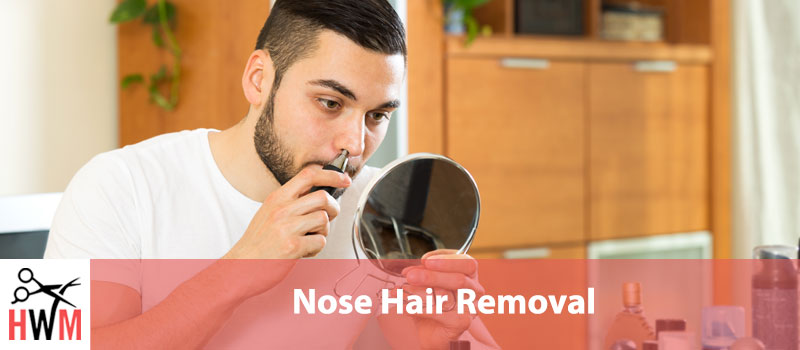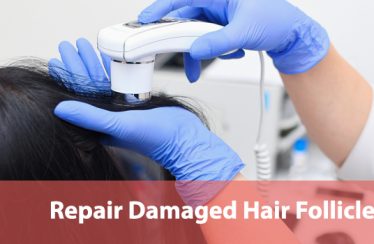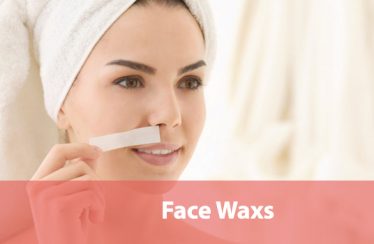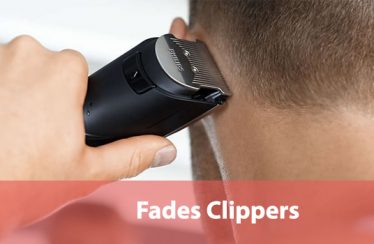It’s unfortunate but true. You just found a nose hair. Not a nose hair neatly contained within your nostrils. Not even a nose hair that’s just poking out, but barely visible.
No. You have a long, unsightly, noticeable, nose hair.
The truth is, almost every man will have to deal with long nose hairs at some point. As you get older, you’re likely to get hairier, including in and around your nose. Not to mention your ears, chest, back, and other places.
Fortunately, we live in a time that nose hair removal is easier than ever before. You don’t have to deal with the ugly bit of hair on your face. There are lots of options for effective nose hair removal.
We’ll cover your options, how long they last, and how comfortable each solution is. We’ll also talk about why you have nose hair in the first place and cover some tips to make the whole process more effective.
- When Should You Consider Nose Hair Removal?
- What Does Nose Hair Do?
- Does Removing Your Nose Hair Cause Problems?
- Nose Hair Removal Methods
- Side Effects from Removing Nose Hair
- Tips for Removing Nose Hair
When Should You Consider Nose Hair Removal?
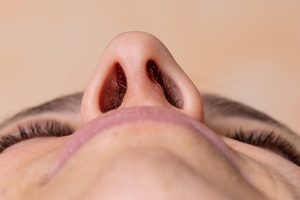
Everyone has nose hair. Everyone. Men, women, even little kids have some nose hair. Most of the time, nose hair isn’t a big problem.
But, if you’re a guy, chances are you’ll need to start grooming your nose hair at some point.
There are a few ways to know that it’s time to start nose hair removal.
The most obvious is when you can see your nose hairs clearly. They don’t necessarily have to be long or stick out from the bottom of your nostrils, to be a problem. If you have thick, visible nose hairs right at the base of your nostrils, but still inside, you may want to start removing them.
You can also get longer nose hairs that stick out from your nostrils onto your upper lip. Even if you have a mustache, you should consider removing your nose hairs. Despite the extra hair there to hide them, hair coming directly from your nostrils will still be noticeable.
Another reason to consider removing your nose hair is difficulty breathing through your nose. Even if the visual effects of dense long nose hairs don’t bother you, all the hair traps mucous and dust, making it harder to get air through your nostrils.
This is a side effect that’s very slow and gradual, so you might not notice it right away. If you find yourself breathing through your mouth more than normal one day, it’s a good idea to check your nose hair situation.
Of course, you also don’t have to have a specific reason to want to remove some of your nose hair. Some people just prefer the feeling of a more open nostril.
What Does Nose Hair Do?
This is a big question for a lot of people. It seems like such a nonsensical place for hair to grow, right? What possible service could little hairs in your nose serve?
Once you know the reason, however, it seems obvious.
All those little hairs provide extra surface area inside your nostrils. Breathing through your nose is meant to help protect your lungs and preserve important resources (like water) inside your body. Your nose acts as a temperature regulator, humidity absorber, dust and debris filter, and more.
That’s why you have mucous in your nose. It catches the dust and debris before airborne irritants can get to your lungs.
The hair that grows in your nose provides more surface area for that mucous and helps to filter the air you breathe.
You don’t need the longer hairs though. Especially if they grow outside your nostrils, they stop serving the same purpose. In fact, it’s hairs further up in your nose that do most of the heavy lifting.
Does Removing Your Nose Hair Cause Problems?
Now that you know that your nose hairs serve a real purpose, you’re probably wondering if removal is a good idea.
After all, if your body has a built-in filter, you want it to be working, right?
Of course, you do. The good news is that proper nose hair removal won’t impact your nose where it matters most. You’re only going to be removing the bottom-most hairs. And, depending on your removal method, you may not even be completely removing those.
While there can be some unwelcome side effects from removing your nose hairs (we’ll talk about those later), your nose’s natural filter system shouldn’t be affected.
Nose Hair Removal Methods
Okay, now we’ve talked about why you have nose hair in the first place. Let’s look at how to get rid of the troublesome hairs.
None of these methods are perfect, and you may find yourself using a combination of several different methods. That’s Okay. Just like any part of your grooming routine, the most important part is finding your method, not the method.
Scissors

Scissors are the first and most common method men use to contain their nose hairs. It’s also one of the oldest methods since scissors have likely been used to remove nose hair for almost as long as there have been scissors.
These days though, not just any pair of scissors will do. You need to have specific nose trimming scissors. Nose trimming scissors are a little like small safety scissors. The tips of the blades are completely dull and curved. That helps to protect you, and the inside of your nose, from any accidents.
The blades are almost always made from stainless steel. Stainless is reasonably easy to clean and care for. It takes a good blade and will stay sharp longer than softer metals. You need a combination of safety and sharp to effectively trim nose hair.
Just like your facial hair, overgrown nose hairs can be thick. And cutting through fibers is a difficult task for a blade. You want something that’s up to the job.
Look for small specialty nose trimming scissors. Hair scissors and nail scissors, which are both sharp enough to do the job, can be too large, too pointed, and too imprecise to safely use inside your nostrils.
Once you have your scissors, slowly work your way around the inside of your nostril. Clip as you go. Go ahead and move slowly, especially the first few times. Listen to your body and your instincts. And don’t insert the scissors more than a few millimeters into your nose.
You’re only looking to trim the visible hair. You don’t need to take the hair down to the root, and you don’t need to remove all the hair in your nose.
The good news about this method is that it’s easy, cheap, and usually painless.
Unfortunately, if this is your chosen method of nose hair removal, you’ll have to do it a bit more often. Plan on trimming your nose hairs at least once a week. You may need to trim them as often as every other day, though, depending on how fast and how thick your nose hair tends to grow.
You’ll also need to clean up the clippings, and thoroughly clean your scissors, before and after trimming. That’s because one of the things your nose filters out are bacteria, and you don’t want those bacteria multiplying on your grooming tools.
Nose Hair Trimmers
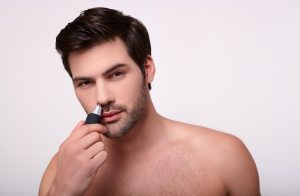
Another option, and one that requires a little less dexterity, are specially designed electric nose trimmers. These trimmers are designed specifically for your nose and can be a separate tool, or an attachment to your electric shaver.
They are the most similar method to using scissors. A trimmer doesn’t trim your hair all the way down to the root, and they aren’t designed to go far enough up your nose to cause damage.
The top of the trimmer is usually the only part of the trimmer that actively cuts hair.
Like scissors, you’ll gradually move around the inside of each nostril. You’ll need to occasionally stop to clean out the trimmer and get rid of the hair trimmings and other debris in your nose.
The good news is that there is even less risk with electric nose trimmers than there is with scissors. Since the trimmer is fully protected, you’d almost have to be trying to hurt the inside of your nose with an electric trimmer.
It’s worth knowing that not all electric nose trimmers are waterproof. Those that are, are much easier to clean, just run them under the sink and then disinfect. But electric trimmers that aren’t waterproof still need to be cleaned and disinfected between every use.
Waxing
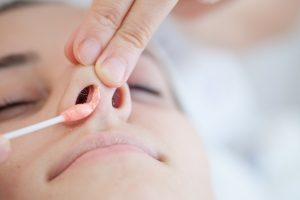
This removal method is a little controversial. While certainly effective and popular, some people think that it’s too easy to remove more hair than you want to. There are also concerns that the longer-term removal could pose more of a problem than short-term removal.
Waxing your nose hair is just like waxing other hair, although you should buy wax designed specifically for your nose.
You can do it yourself with an at-home kit, or you can go to a professional to get nose waxing done.
Unfortunately, this is one of the most painful ways to remove nose hair. And once you start, you can’t stop. Especially if your nose hair is visible, you’ll need to do both nostrils before you stop, even if you never wax again.
Waxing can provide relief from nose hairs for weeks, and even months at a time. That’s because the wax will remove the hair at the root, forcing each follicle to rest and heal before starting to grow a new hair. Your nose hairs also grow especially slowly, since it isn’t exactly an area that needs long hair.
The actual details of waxing are simple. You’ll heat the specially formulated wax, and then apply it just inside your nostril (one at a time), using an applicator. Most home kits will include the applicator along with the wax.
Wait for the wax to cool slightly and harden, then pull. You’ll want to use one sharp, fast, and firm motion for this. Pulling more slowly will only make the process hurt more and take longer. While waxing can sting and hurt at first, your nose will quickly go back to feeling normal.
This isn’t a good option for men with low pain tolerance or especially sensitive noses. We recommend trying to wax your arm, leg, eyebrows, or ears before your nose, so you have a sense of what waxing feels like.
That way you’re fully prepared, and less likely to hesitate when it’s time to wax your other nostril.
However, there is some concern that waxing will irritate the mucous lining in your nose, which can be more painful and last longer. If you have especially thick hair, you should be cautious with this approach, and start with the smallest possible amount of wax.
Plucking
Like waxing, plucking involves removing the hair from your nose at the root. It’s a longer-lasting form of nose hair control. But, like waxing, it can be a painful process to complete. The tools are simpler though, all you need is a pair of tweezers and you’re ready to get started.
All you need is a firm grip on the hair (try to only grab 1-2 strands at a time), and a sharp pull to remove the hair.
You’ll need to keep your tweezers very clean, and we recommend cleaning them before and after using them.
This method is the slowest of the options we’ve discussed so far. You’re removing less hair in one go. It also takes a lot of dexterity, since your selecting individual hairs. We highly recommend a hand-held magnifying mirror to make this process easier.
Plucking is usually best for men who don’t have a lot of nose hair they need to remove. If you only have a few strands in each nostril, this may even be the easiest method. But for men with more hair to worry about, plucking will take too long.
Plucking will also be too painful for most men with a lot of hair. Unlike waxing, plucking will continue to hurt, because you’re continuing to pull hairs and irritate the inside of your nostrils.
Laser Hair Removal
This last option is very new and still controversial. Laser hair removal is a near-permanent solution for unwanted hair. But, that doesn’t mean that it’s a good option for nose hair.
This method is also only effective for men with light skin. Black men, and Latino or Asian men with darker pigmentation shouldn’t use laser hair treatments because the laser will attack the melanin in your skin and can cause burns.
The other big concern with laser hair removal is that it might damage the delicate mucous lining in your nose. Some dermatologists are comfortable with the procedure and think that it’s a safe and effective option. Others worry that laser hair removal could have unintended consequences in the nostril.
It’s up to you whether you want to give laser hair removal a try. You should also know that you’ll likely need maintenance appointments once a year, or once every two years.
Laser nose hair removal should never be attempted at home, or by non-professionals. If you choose to go ahead with laser hair removal, seek a licensed dermatologist or plastic surgeon who offers the treatment.
You need a professional because of how small and delicate your nostrils are. Precision is key, and you need to balance the treatment to remove unwanted hair without damaging the surrounding skin.
Side Effects from Removing Nose Hair
Like most grooming routines, there are some possible side effects of regular nose hair removal. If you have any of these problems crop up, wait for a few days before treating your nose hair again. If the problem becomes consistent, consult with a doctor or dermatologist for options.
Ingrown Hairs
Similar, but sometimes more painful and long-lasting, than pimples inside your nose, ingrown hairs are one of the most common side effects of nose hair removal. These should only be an occasional nuisance, though. If you get regular ingrown hairs, try a different method.
The best solution for ingrown hair is usually just time and good hygiene. In the meantime, however, your nose might be more irritated. It can feel itchy and even swell slightly near the ingrown hair.
Fortunately, these should only take a few days to resolve. If it takes longer, consult with a dermatologist.
Irritated Mucous Lining

This is a less common reaction and usually comes with waxing or other more invasive methods of hair removal.
It should resolve on its own, and quickly. Your nose may swell slightly, you may feel congested, or your nose may start to run.
If you’re prone to bloody noses, you might also get one of those. However, if this reaction is consistent after removing your nose hair, you’re either doing something wrong or using an unsuitable method.
Try switching to one of the gentler hair removal methods to see if your nose handles it better.
Cuts and Nicks
Most common from using scissors, small cuts are no big deal, just painful. The cut should stop hurting within about 24 hours and should heal after only a couple of days after that.
If you do nick the inside of your nose, and it doesn’t heal quickly, starts bleeding again after stopping, or your nose starts to itch and go red, you should consult with a doctor to make sure you don’t have an infection.
Do not try to use an antibacterial ointment or other treatment to clean the nick. Even if you do need to treat the cut for infection, normal antibiotic creams and ointments for your skin should not be put in your nostrils.
Tips for Removing Nose Hair
These tips aren’t specific to any one method. Instead, these are things you can do to make all of the at-home methods of hair removal easier and more effective.
If you get a professional to help with your nose hair, they’ll probably appreciate these steps too!
Blow Your Nose!

This might seem obvious to some, but you should always try to clear out your nose before you try to trim your nose hairs.
Blow both sides of your nose until you don’t get anything out. We don’t necessarily recommend using a neti pot or nasal wash since those treatments can make your nostrils more sensitive.
Don’t try to remove nose hairs if your nose already feels irritated, swollen, or clogged. Wait until the situation calms down.
Be Gentle
This is super important. The inside of your nose is one of the more sensitive areas of your body. You should try to move slowly and intentionally. And if your nose really doesn’t like something, don’t do it.
You can even be gentle waxing, by being quick and firm.
Taking a few extra minutes in your grooming routine to keep yourself comfortable will make it much easier to keep your nose hairs in check.
Wash Your Face Before and After
Your nostrils are home to a lot of bacteria. Sure, they don’t stay there long, but you still don’t want to get them all over your face.
Washing your face before will help keep dirt and oil out of your way. Washing after you remove your nose hairs will make sure that none of the trimmings stay on your face, while also washing away any bacteria that might have spread out of your nostrils and onto your face.
You should also remember to moisturize after washing your face. Especially if you have an anti-bacteria or soothing moisturizer. That way you’ll look good, feel good, and won’t have to worry about dried skin.
Final Thoughts
Hopefully, you have a better sense of your options after reading this article. We’ve gone over how you can tell that you should consider nose hair grooming. We’ve talked about how nose hair functions as a filter, and why the job is important.
But we’ve also outlined why nose hair removal won’t negatively impact that natural filter.
Most importantly, we’ve gone over all the common methods of nose hair removal. We’ve talked about each method, the tools you need, how long the hair removal is likely to last, and some reasons why you might want to choose one method over another.
Lastly, we’ve covered the most common side effects of nose hair removal, and given you some tips to make the whole process easier, more comfortable, and more sanitary.
Whether you already have your first nose hair or are just trying to be prepared, you should be ready to add nose hair removal to your normal grooming routine.
